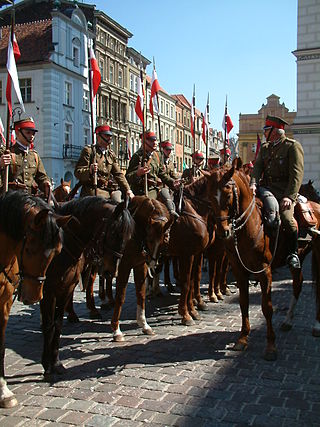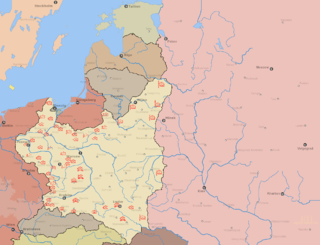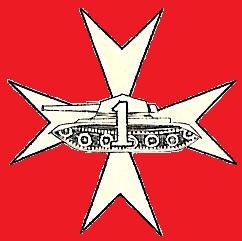
The Polish cavalry can trace its origins back to the days of medieval cavalry knights. Poland is mostly a country of flatlands and fields and mounted forces operate well in this environment. The knights and heavy cavalry gradually evolved into many different types of specialised mounted military formations, some of which heavily influenced western warfare and military science. This article details the evolution of Polish cavalry tactics, traditions and arms from the times of mounted knights and heavy winged hussars, through the times of light uhlans to mounted infantry equipped with ranged and mêlée weapons.

Lieutenant General Stanisław Maczek was a Polish tank commander of World War II, whose division was instrumental in the Allied liberation of France, closing the Falaise pocket, resulting in the destruction of 14 German Wehrmacht and SS divisions. A veteran of World War I, the Polish–Ukrainian and Polish–Soviet Wars, Maczek was the commander of Poland's only major armoured formation during the September 1939 campaign, and later commanded a Polish armoured formation in France in 1940. He was the commander of the famous 1st Polish Armoured Division, and later of the I Polish Army Corps under Allied Command in 1942–45.

The Polish 1st Armoured Division was an armoured division of the Polish Armed Forces in the West during World War II. Created in February 1942 at Duns in Scotland, it was commanded by Major General Stanisław Maczek and at its peak numbered approximately 18,000 soldiers.The division served in the final phases of the Battle of Normandy in August 1944 during Operation Totalize and the Battle of Chambois and then continued to fight throughout the campaign in Northern Europe, mainly as part of the First Canadian Army.

The PT-91 Twardy is a Polish main battle tank. A development of the T-72M1, it entered service in 1995. The PT-91 was designed at the OBRUM and is produced by the Bumar Łabędy company, part of the Bumar Group, a Polish technical military consortium. Changes from the T-72M include a new dual-axis stabilized fire-control system, reactive armour, a more powerful engine, transmission and new automatic loader.

This article discusses the Polish order of battle during the invasion of Poland. In the late 1930s Polish headquarters prepared "Plan Zachód", a plan of mobilization of Polish Army in case of war with Germany. Earlier, the Poles did not regard the Germans as their main threat, priority was given to threat from the Soviets.

The Volhynian Cavalry Brigade was a Polish cavalry brigade, which saw action against the invading Germans during the Invasion of Poland, a part of World War II. Raised from recruits in the area of Wołyń, the division was posted to the Łódź Army. During several desperate counter-attacks, the brigade suffered heavy casualties near Łódź. It was commanded by Colonel Julian Filipowicz. Most notably, the unit took part in one of the first battles of the German invasion of Poland, the battle of Mokra.

The 10th Cavalry Brigade was a Polish military unit in World War II. It was the only fully operational Polish motorized infantry unit during the Invasion of Poland, as Warsaw Armoured Motorized Brigade was not completed by September 1, 1939.

The Battle of Jordanów took place on 1–3 September 1939, during the Invasion of Poland and the opening stages of World War II. It was fought between the German XVIII Panzer Corps of Gen.E.Beyer and the Polish 10th Motorized Cavalry Brigade under Col. Stanisław Maczek.
Kraków Army was one of the Polish armies which took part in the Polish Defensive War of 1939. It was officially created on March 23, 1939 as the main pivot of Polish defence. It was commanded by Gen. Antoni Szylling. Originally, Kraków Army was to be made of seven infantry divisions, two cavalry brigades and one mountain brigade. On September 1, 1939, General Szylling had the force which consisted of five infantry divisions, two cavalry brigades and one brigade of mountain infantry. Altogether, the army was made of 59 battalions, 29 squadrons, 352 cannons, 90 tanks, two armoured trains and 44 planes. These forces were not enough to halt German advance, especially in the area north of Częstochowa, where Kraków Army connected with Łódź Army. Main thrust of Wehrmacht panzer units was directed there, and this area was defended only by the Polish 7th I.D., which was destroyed in the early days of September 1939, opening the way towards central Poland.
The Battle of Jarosław took place between 10 and 11 September 1939 in the city of Jarosław on the San River. During the battle the Polish forces of General Stanisław Maczek successfully held the river crossings in the town for two days against the Nazi German Wehrmacht, which was enough time for the Polish 10th Motorized Cavalry Brigade to cross the river and retreat further eastwards.

Army Poznań, led by Major General Tadeusz Kutrzeba, was one of the Polish Armies during the Invasion of Poland in 1939.

The Polish Army in France formed in France under the command of General Władysław Sikorski in late 1939, after the fall of Poland resulting from the Polish Defensive War. About 85,000 troops were in the process of being organized into fighting formations when the Battle of France started. The army was partially destroyed in the hostilities, but over 20,000 soldiers were evacuated and formed a new Polish army in the United Kingdom.
The Warsaw Armoured Motorized Brigade was a motorized unit of the Polish Army during the interbellum period. The brigade was one of two such units in Poland. Not fully formed by September 1, it was nonetheless partially combat ready and immediately rushed into battle during the Polish September Campaign. Following heavy losses during the Battle of Tomaszów Lubelski, it was disbanded on September 20, 1939.

The 3rd Polish Infantry Brigade was a Polish infantry brigade which served during World War II. Together with the 10th Armoured Cavalry Brigade they formed part of the 1st Polish Armoured Division and was created from Polish soldiers who had already escaped from Poland to France, and after the fall of France made their way to Great Britain. Their wartime headquarters were in Biggar High School, South Lanarkshire
The Polish 1st Cavalry Division was a formation of the Polish Army between the World Wars. Formed in 1919, partially of veterans of the Polish Legions, the unit saw extensive action during the Polish-Bolshevik War.

15th Poznań Uhlan Regiment – unit of Polish cavalry, part of Greater Polands Army, Polish Army of Second Republic and Polish Armed Forces in the West during World War II.

The 1st Armoured Regiment was an armoured regiment of the Polish Armed Forces in the West during World War II, part of the 1st Armoured Division.
The 11th "Lubuska" Armoured Cavalry Division is an armoured division of the Polish Land Forces, which traces its history to the formation of the 11th Infantry Division of the Polish Armed Forces in the East in 1945.

This article deals with the history and development of tanks of the Polish army from their first use after World War I, into the interwar period, during World War II, the Cold War and modern era.
Reference: "With the tanks of the 1st Polish Armoured Division" A Tomaszewska (H L Smit and zn, Hengelo, Holland [sic], 1946)
















